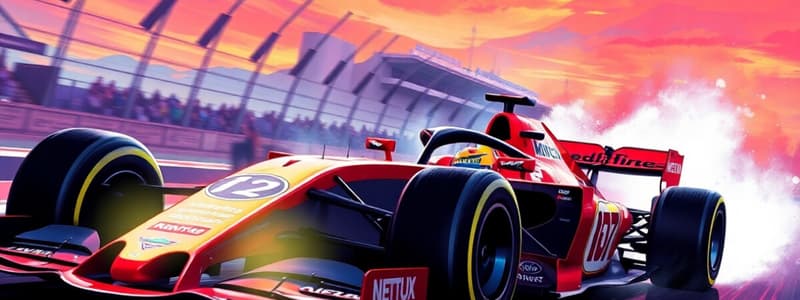Podcast
Questions and Answers
A driver sees a black flag with an orange dot (meatball flag) being displayed. What is the correct procedure they should follow?
A driver sees a black flag with an orange dot (meatball flag) being displayed. What is the correct procedure they should follow?
During a Full Course Yellow (FCY), drivers are allowed to overtake each other to gain positions before the restart.
During a Full Course Yellow (FCY), drivers are allowed to overtake each other to gain positions before the restart.
What should a driver do upon seeing a blue flag?
What should a driver do upon seeing a blue flag?
The ______ flag is displayed to signal the end of a race or session.
The ______ flag is displayed to signal the end of a race or session.
Match each flag with its correct meaning.
Match each flag with its correct meaning.
What is the primary purpose of the free practice sessions during a Grand Prix weekend?
What is the primary purpose of the free practice sessions during a Grand Prix weekend?
The Grand Prix race distance is always exactly 305 km, regardless of the track length or race conditions.
The Grand Prix race distance is always exactly 305 km, regardless of the track length or race conditions.
How does sprint qualifying differ from traditional qualifying in a Grand Prix weekend?
How does sprint qualifying differ from traditional qualifying in a Grand Prix weekend?
In the start procedure, the __________ lap allows drivers to check their systems and warm up their tires before the official start of the race.
In the start procedure, the __________ lap allows drivers to check their systems and warm up their tires before the official start of the race.
What does a double yellow flag indicate during a race?
What does a double yellow flag indicate during a race?
A driver who sets the fastest lap during a Grand Prix always receives a championship point, regardless of their finishing position.
A driver who sets the fastest lap during a Grand Prix always receives a championship point, regardless of their finishing position.
Match the qualifying session with its description:
Match the qualifying session with its description:
What is the benefit of drivers avoiding the 'dirty' side of the track during the formation lap?
What is the benefit of drivers avoiding the 'dirty' side of the track during the formation lap?
Flashcards
Green Flag
Green Flag
Red Flag
Red Flag
Blue Flag
Blue Flag
Black Flag with Orange Dot (Meatball Flag)
Black Flag with Orange Dot (Meatball Flag)
Virtual Safety Car (VSC)
Virtual Safety Car (VSC)
Grand Prix Event
Grand Prix Event
Free Practice Sessions
Free Practice Sessions
Qualifying
Qualifying
Race Duration
Race Duration
Championship Points
Championship Points
Sprint Race Weekend
Sprint Race Weekend
Formation Lap
Formation Lap
Yellow Flag
Yellow Flag
Study Notes
F1 Grand Prix Overview
- Grand Prix events are festivals of excitement and entertainment spanning 3-4 days.
- The race is the culminating event of a traditional Grand Prix weekend.
Free Practice Sessions
- These sessions occur over a couple of days before race day.
- Teams and drivers use this time to learn the track and experiment with conditions.
- It's crucial for testing different setups and configurations for qualifying and the race.
Qualifying
- Drivers aim to set the fastest possible lap times.
- The qualifying session is divided into three knockout sessions: Q1, Q2, and Q3.
- The fastest driver overall starts the race from Pole Position.
- Remaining drivers line up behind in order of qualifying lap time.
Race Duration
- A Grand Prix distance is 305 km.
- The number of race laps is calculated by dividing 305 km by the length of a single lap and rounding up.
- An exception is if the race exceeds a 2-hour time limit due to stoppages.
- The first car to cross the finish line after the final lap wins.
Championship Points
- Awarded to the top 10 drivers.
- First place receives 25 points, and 10th place gets one point.
- A point is awarded for setting the fastest lap, even to drivers outside the top 10.
Sprint Race Weekends
- This format has one practice session before the competitive weekend.
- It includes sprint qualifying and a shorter race called the F1 Sprint.
- Sprint weekends happen a few times per season at predetermined races.
Sprint Qualifying and Sprint
- Sprint qualifying determines the grid order for the Saturday Sprint.
- The Sprint is a shorter race with no mandatory pit stops.
- Only the top eight finishers in a Sprint get points.
Race Start Procedure
- Cars are moved from garages to the grid 40-50 minutes before the race.
- Mechanics and engineers maintain the cars' condition.
- The formation lap is a reduced-speed tour for systems check and tire warm-up.
- Drivers avoid dirty sides of the track to keep tires clean.
Start Lights
- Five red lights illuminate one by one, signaling the start.
- Drivers focus on the track, reacting to the lights going off.
- Aborted starts can occur due to various issues, including car breakdowns or weather.
- In bad weather, the race may start behind the safety car.
Flags in F1 Racing
- Flags are a quick and simple visual communication method in racing.
- Electronic boards and driver dash displays support the flag system.
Yellow Flags
- Single yellow: Reduce speed, prepare for a hazard, no overtaking.
- Double yellow: Reduce speed significantly, be ready to stop.
- During qualifying, drivers should abandon their lap under yellow flags.
- Yellow with red stripes: Reduced grip ahead due to oil spillage or water.
- Full Course Yellow (FCY): Yellow flag rules apply to the entire track.
Green Flag
- Indicates the track is clear, and racing can resume.
Red Flag
- Indicates to slow down immediately and prepare to stop.
- Is used when the circuit is deemed temporarily unsafe.
- Drivers return to the pit lane slowly and carefully.
Blue Flag
- During practice and qualifying, means faster car(s) approaching.
- During a race, it indicates a driver is about to be lapped- they must allow the faster car(s) to pass
Black and White Flag
- A warning for unsportsmanlike behavior or track limits violations.
Black Flag with Orange Dot (Meatball Flag)
- Indicates the cars have damage and must return to the pits for repairs.
Black Flag
- Signifies disqualification; the driver must return to the pits immediately.
Checkered Flag
- Signals the end of the session/race.
- In the race, it is waved at the finish line for the winner and subsequent drivers.
Safety Car
- Deployed when an incident is too serious for flags alone.
- The car in first place follows the safety car at a reduced speed.
- No overtaking is allowed under safety car conditions.
- Restarts occur after the safety car peels away, with the lead driver controlling pace.
Virtual Safety Car (VSC)
- Neutralizes the race by limiting drivers to a set slower speed.
- Preserves gaps between cars, unlike a full safety car.
Studying That Suits You
Use AI to generate personalized quizzes and flashcards to suit your learning preferences.




